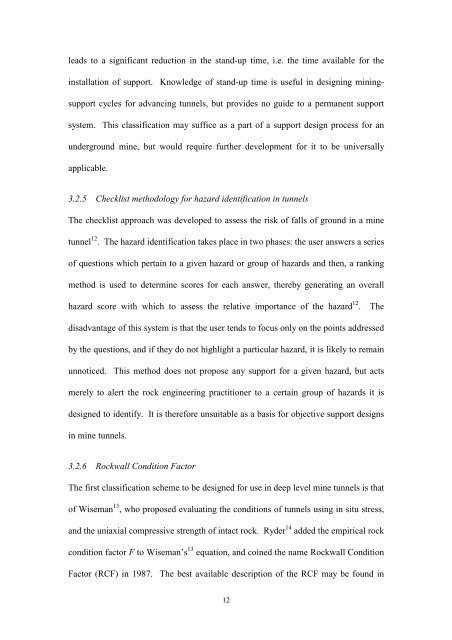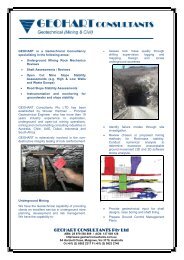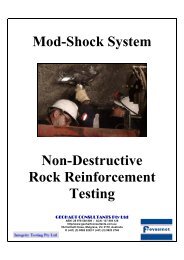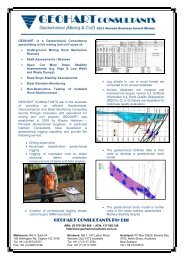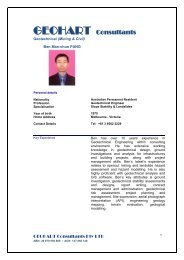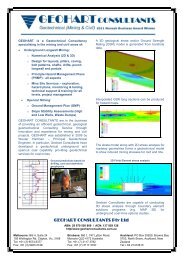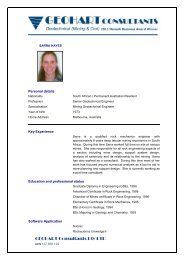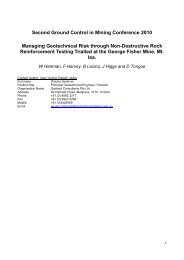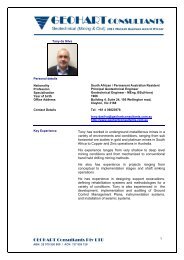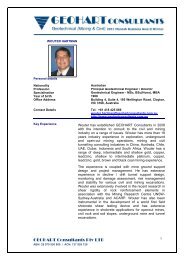The application of the q tunnelling quality index - Geohart Consultants
The application of the q tunnelling quality index - Geohart Consultants
The application of the q tunnelling quality index - Geohart Consultants
Create successful ePaper yourself
Turn your PDF publications into a flip-book with our unique Google optimized e-Paper software.
leads to a significant reduction in <strong>the</strong> stand-up time, i.e. <strong>the</strong> time available for <strong>the</strong><br />
installation <strong>of</strong> support. Knowledge <strong>of</strong> stand-up time is useful in designing miningsupport<br />
cycles for advancing tunnels, but provides no guide to a permanent support<br />
system. This classification may suffice as a part <strong>of</strong> a support design process for an<br />
underground mine, but would require fur<strong>the</strong>r development for it to be universally<br />
applicable.<br />
3.2.5 Checklist methodology for hazard identification in tunnels<br />
<strong>The</strong> checklist approach was developed to assess <strong>the</strong> risk <strong>of</strong> falls <strong>of</strong> ground in a mine<br />
tunnel 12 . <strong>The</strong> hazard identification takes place in two phases: <strong>the</strong> user answers a series<br />
<strong>of</strong> questions which pertain to a given hazard or group <strong>of</strong> hazards and <strong>the</strong>n, a ranking<br />
method is used to determine scores for each answer, <strong>the</strong>reby generating an overall<br />
hazard score with which to assess <strong>the</strong> relative importance <strong>of</strong> <strong>the</strong> hazard 12 . <strong>The</strong><br />
disadvantage <strong>of</strong> this system is that <strong>the</strong> user tends to focus only on <strong>the</strong> points addressed<br />
by <strong>the</strong> questions, and if <strong>the</strong>y do not highlight a particular hazard, it is likely to remain<br />
unnoticed. This method does not propose any support for a given hazard, but acts<br />
merely to alert <strong>the</strong> rock engineering practitioner to a certain group <strong>of</strong> hazards it is<br />
designed to identify. It is <strong>the</strong>refore unsuitable as a basis for objective support designs<br />
in mine tunnels.<br />
3.2.6 Rockwall Condition Factor<br />
<strong>The</strong> first classification scheme to be designed for use in deep level mine tunnels is that<br />
<strong>of</strong> Wiseman 13 , who proposed evaluating <strong>the</strong> conditions <strong>of</strong> tunnels using in situ stress,<br />
and <strong>the</strong> uniaxial compressive strength <strong>of</strong> intact rock. Ryder 14 added <strong>the</strong> empirical rock<br />
condition factor F to Wiseman’s 13 equation, and coined <strong>the</strong> name Rockwall Condition<br />
Factor (RCF) in 1987. <strong>The</strong> best available description <strong>of</strong> <strong>the</strong> RCF may be found in<br />
12


